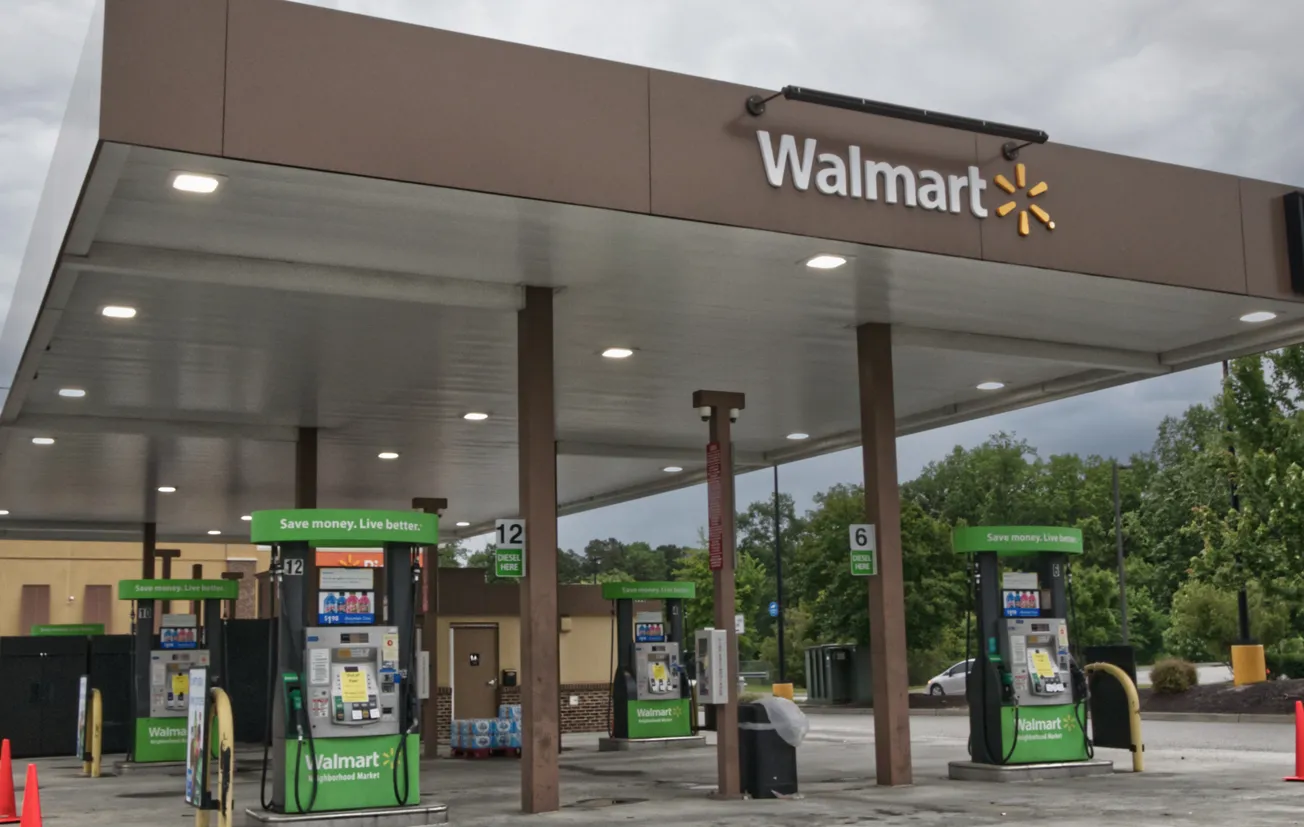Walmart is aggressively re-entering the convenience store and fuel station market with an integrated model that leverages its expansive U.S. store footprint and evolving customer loyalty program.
With more than 400 fuel and c-store locations now operating across 34 states—and more than 45 additional builds or remodels planned for 2025—the retail giant is signaling a serious commitment to competing in a segment historically dominated by independent operators and regional chains.
This effort builds on and significantly diverges from Walmart’s earlier fuel and convenience initiatives, including its multi-decade partnership with Murphy USA and various now-defunct small-format retail experiments.
The current model is designed to increase trip consolidation, reward Walmart+ loyalty members, and maximize underutilized parking lot real estate to attract incremental revenue.
Revisiting the Murphy USA Era: A Franchise Approach to Fuel Retailing
Walmart’s earliest large-scale fuel retailing strategy was defined by a longstanding partnership with Murphy USA, an Arkansas-based fuel company originally spun off from Murphy Oil Corporation.
Starting in the early 2000s, Murphy USA developed and operated fuel stations adjacent to Walmart stores, especially in the Southeast and Midwest.
This franchised model helped Walmart provide low-price fuel options without directly entering the petroleum business. Murphy’s small-footprint stations typically offered just fuel and a limited convenience assortment.
At its peak, Murphy operated hundreds of stations under this co-branded relationship.
In 2016, however, Walmart announced that it would begin building and operating its own fuel and convenience locations independently of Murphy USA. This decision followed a reassessment of how Walmart could better integrate c-store and fuel offerings into its broader retail strategy, and the partnership was gradually scaled back.
Murphy USA has since focused on standalone growth and now competes directly with Walmart in some markets.
The departure from the Murphy model marked a key inflection point, allowing Walmart to fully control branding, merchandising, loyalty integration, and pricing strategies in its c-store operations.
Unlike Murphy's leased model, Walmart’s current efforts embed the c-store experience directly into the broader shopping journey.
Sam’s Club: A Parallel Strategy with Fuel and Bulk Convenience
Walmart’s wholesale arm, Sam’s Club, has independently built out its own fuel retail strategy, albeit under a different operational logic.
Many Sam’s Club locations feature fuel stations that are accessible only to members, reinforcing the value proposition of membership through consistently lower gas prices. These fuel stations typically do not include full-fledged c-stores, but instead offer limited snack/beverage options or vending setups.
What sets the Sam’s Club approach apart is its strategic use of fuel as a membership retention and acquisition tool. According to industry reports, Sam’s Club fuel stations have become a key traffic driver, especially in price-sensitive regions.
The club format also benefits from economies of scale in fuel procurement and loyalty pricing, which Walmart is now emulating through its Walmart+ integration at corporate-owned fuel sites.
Sam’s Club’s success in fuel, while separate from the new Walmart c-store model, has likely informed corporate thinking around the viability of in-house fuel operations—and the critical importance of pairing them with broader retail incentives.
Lessons from Discontinued Formats: Walmart Express, To Go, and Campus Stores
Before shifting to the integrated fuel and convenience model, Walmart tested a series of smaller-format retail concepts:
- Walmart Express (2011–2016): Targeted at small towns and urban neighborhoods, these 12,000–15,000 square foot stores were designed to serve communities lacking access to Supercenters. While they offered grocery, pharmacy, and limited general merchandise, the format struggled to achieve profitability and was ultimately discontinued. Some sites were sold to Dollar General.
- Walmart To Go (2014): A one-off concept piloted in Bentonville, Arkansas, combining a gas station with a 5,200-square-foot convenience retail store. It served as a testing ground for integrating grocery and fuel, but the model was never scaled.
- Walmart on Campus (2011–2016): Aimed at students, these 2,500–6,000 square foot stores offered snacks, toiletries, pharmacy items, and other dorm-room essentials. Locations at the University of Arkansas and Arizona State University were eventually closed after limited adoption and questions about long-term sustainability.
These failed formats underscored the difficulties Walmart faced in adapting its traditional high-volume, low-margin model to smaller-scale environments.
The company’s current approach—layering convenience onto existing Supercenter infrastructure—is designed to avoid these pitfalls by keeping capital costs low and maximizing synergies with its core business.
Competitive Landscape: Buc-ee’s and the Rise of Destination Convenience
The latest c-store expansion by Walmart also comes amid broader growth in the sector. Most notably, Texas-based Buc-ee’s has redefined the upper end of the convenience experience, constructing travel centers that often exceed 75,000 square feet.
Featuring dozens of fuel pumps, massive foodservice offerings, and highly trafficked restrooms, Buc-ee’s operates more like a retail destination than a traditional c-store.
The comparison is notable: Buc-ee’s, in both scale and customer experience, is closer in size to Walmart Express than to standard fuel stations, reflecting a demand for more robust, diversified offerings in a traditionally limited space.
However, Walmart’s ambitions are not to compete directly with Buc-ee’s scale, but rather to increase value and convenience at the daily shopping level. Its current model focuses on frequent, lower-basket trips tied to grocery runs and Walmart+ perks rather than road-trip tourism.
Market Outlook
Walmart’s integrated c-store strategy appears to be more focused and sustainable than previous efforts, given the operational advantages of leveraging existing store real estate, bundling services with Walmart+, and maintaining control over the customer journey.
By taking lessons from the Murphy USA partnership, drawing inspiration from Sam’s Club’s loyalty-driven fuel model, and avoiding the overhead of standalone builds, Walmart is positioning itself for more durable success in the sector.
Still, challenges remain. Fuel price volatility, environmental concerns, and the gradual rise of electric vehicles will pressure all operators to evolve. Walmart has begun deploying EV charging infrastructure in select locations, but its current fuel stations remain gasoline-focused.
Overall, Walmart’s latest c-store initiative represents a calculated, risk-aware strategy that aligns convenience, fuel, and loyalty—a model that may finally allow it to carve out a durable position in a fragmented, but growing, sector.










